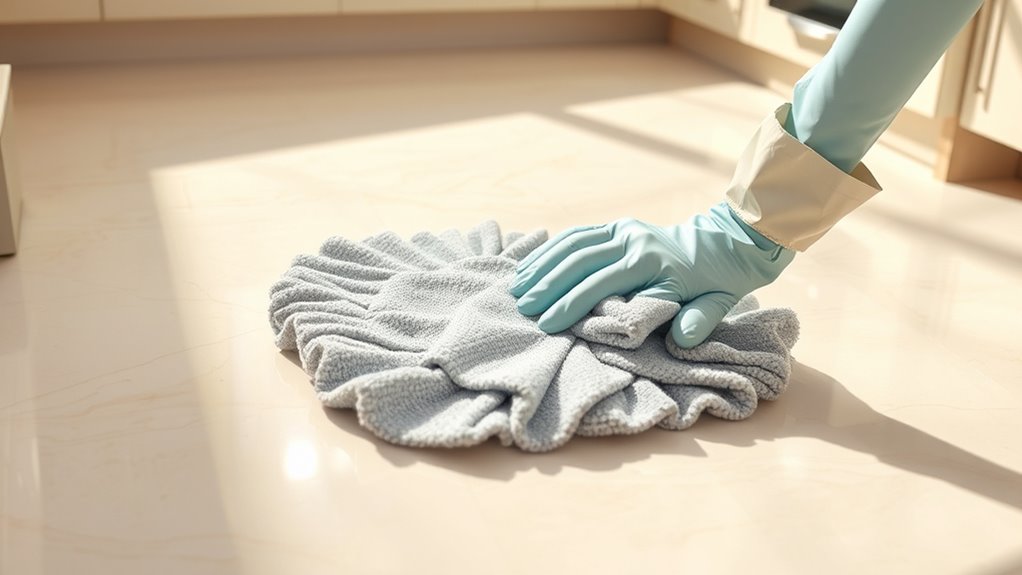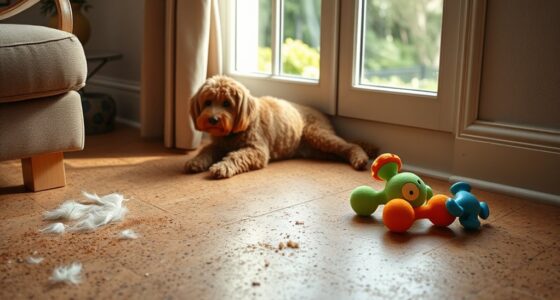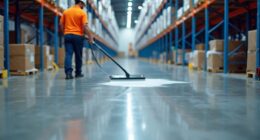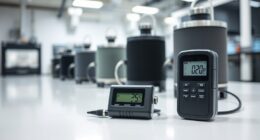To deep-clean linoleum floors without damage, start by sweeping or vacuuming to remove loose dirt, then use a damp mop with a pH-neutral cleaner suited for linoleum. Work in sections, gently scrubbing away stains with a soft cloth or baking soda paste if needed. Rinse often and dry thoroughly to prevent moisture buildup. Applying proper techniques will restore shine and prolong your floor’s life—discover more tips to keep your floors looking pristine.
Key Takeaways
- Sweep or vacuum thoroughly to remove loose debris and dust before mopping.
- Use a damp mop with a pH-neutral, mild cleaner, wringing out excess water to prevent moisture damage.
- Mop in gentle, figure-eight motions, working in small sections for even cleaning.
- Address stains promptly with a soft cloth and a baking soda paste if needed, then rinse and dry.
- Regularly maintain the floor with gentle cleaning to preserve its durability and appearance.

Keeping your linoleum floors looking their best requires more than regular sweeping; sometimes, a deep clean is necessary to remove embedded dirt and stains. To achieve this, you need to master effective mopping techniques that penetrate deep into the surface without causing damage. Start by sweeping or vacuuming the area thoroughly to remove loose debris, dust, and pet hair. This step ensures that when you begin mopping, you’re not just spreading dirt around but lifting it away.
Deep clean your linoleum floors with thorough sweeping and gentle mopping to remove dirt and stains effectively.
For mopping techniques, use a damp mop—not soaking wet—because excess water can seep into the seams and weaken the linoleum over time. Fill your bucket with warm water and add a mild, pH-neutral cleaner designed for linoleum or vinyl flooring. Dip your mop into the solution, then wring it out until it’s just damp. Work in manageable sections, mopping in a gentle figure-eight motion to cover the entire area evenly. Rinse and wring out your mop frequently to avoid redistributing dirt. This method ensures a thorough clean without excessive moisture, which could cause warping or peeling.
When it comes to stain removal, tackling stubborn spots promptly is key. For common stains like ink, coffee, or food spills, apply a small amount of the cleaning solution directly onto the stain and let it sit for a few minutes. Use a soft cloth or sponge to gently scrub the area, avoiding abrasive tools that could scratch or damage the linoleum’s surface. For tougher stains, a mixture of baking soda and water can act as a gentle abrasive. Spread the paste over the stain, let it sit for 10-15 minutes, then scrub softly with a non-abrasive pad before rinsing thoroughly. Always dry the area immediately afterward to prevent moisture retention.
Deep cleaning isn’t just about removing surface dirt; it’s about restoring the vibrancy of your floors. Regular maintenance, combined with these effective mopping techniques and targeted stain removal, will keep your linoleum looking fresh and durable for years. Additionally, practicing space and organization strategies can help prevent dirt buildup and keep your floors cleaner longer. Remember, patience and gentle cleaning are your best tools—harsh scrubbing or overly wet mops can cause more harm than good. By following these steps, you guarantee a deep clean that preserves your flooring’s integrity, enhances its appearance, and keeps it resistant to future stains and damage.
Frequently Asked Questions
Can I Use Bleach to Clean Linoleum Floors Safely?
You shouldn’t use bleach to clean linoleum floors because it can damage the surface. Bleach safety is a concern since it may cause discoloration or deterioration over time. Instead, consider using vinegar, which effectively cleans without harmful effects. Vinegar’s gentle acidity helps break down dirt and grime, leaving your floors bright and safe. Always dilute vinegar properly and avoid harsh chemicals to protect your linoleum.
How Often Should I Deep-Clean My Linoleum Floors?
You should deep-clean your linoleum floors every 4 to 6 months to maintain their shine and longevity. Skipping this can lead to buildup and dullness. Regular maintenance tips like sweeping daily and mopping weekly help, but deep cleaning removes embedded dirt and stains effectively. Think of it as a health check for your floors—staying consistent guarantees they stay beautiful and durable for years.
Will Vinegar Damage Linoleum Surfaces?
Vinegar concerns are common, but it generally won’t damage linoleum surfaces if diluted properly. For linoleum safety, mix one part vinegar with three or four parts water before cleaning. Avoid using straight vinegar or harsh chemicals, as they could weaken the material over time. You can confidently use vinegar as a natural cleaner, knowing it’s safe when diluted correctly, and it helps maintain your linoleum’s shine without damage.
Are Steam Cleaners Safe for Linoleum Flooring?
Steam cleaning can be safe for linoleum flooring if you proceed properly. You’re prompted to prioritize floor safety by using a steam cleaner with a low heat setting and avoiding excessive moisture. Steady, controlled steam helps dissolve dirt without damaging your delicate linoleum. Always test a small area first, and keep the steam cleaner moving to prevent water from seeping into seams, ensuring a safe, sparkling shine.
What’s the Best Way to Remove Stubborn Stains?
For stubborn stain removal on linoleum, start by gently blotting the stain with a mixture of warm water and mild dish soap. Use a soft cloth or sponge, and avoid harsh scrubbing to prevent damage. For tougher stains, apply a paste of baking soda and water, let it sit for a few minutes, then gently scrub. Always follow up with clean water to remove residue, ensuring your cleaning techniques keep your floors looking fresh.
Conclusion
Now that you’ve mastered the art of deep-cleaning your linoleum floors, you might think your job is done. But remember, a truly spotless floor isn’t just about cleaning — it’s about maintaining its beauty over time. With each careful step, you’re preserving more than just its shine; you’re safeguarding its longevity. So, keep your eyes open and stay vigilant. The secret to lasting pristine floors might just be lurking in your next routine.









